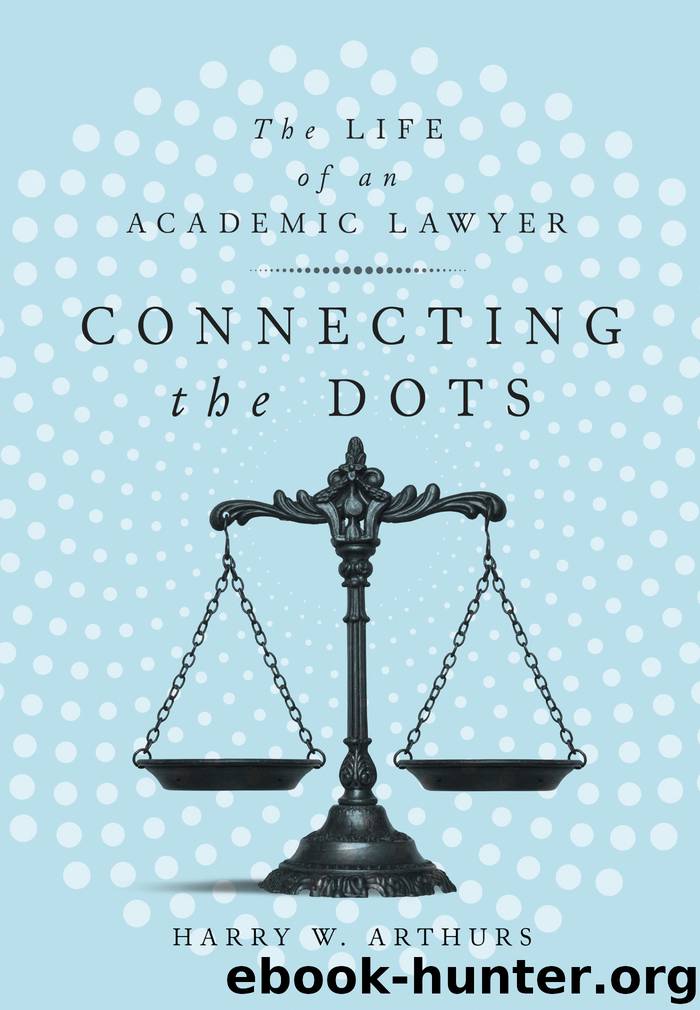Connecting the Dots by Harry W. Arthurs

Author:Harry W. Arthurs
Language: eng
Format: epub
Publisher: MQUP
Published: 2019-05-19T04:00:00+00:00
8
Adventures in Pedagogy
Over my forty-plus years as a legal academic, I had a lot to say about the governance, curricula, and scholarly cultures of law schools, but relatively little to say about what actually goes on in the classroom – a point astutely noted by a friendly commentator on my work on legal education.1 In this chapter, I hope to make amends for my neglect of this important subject by recounting some of my adventures in pedagogy.
To begin somewhere around the middle of my career: a student in labour law intervened in a class discussion one day to say, “I’m sick and tired of hearing how stupid judges are and how clever law professors are.” This prompted a rejoinder from another student: “Listen you,” she said, “This is the best class in the best course I have ever taken in all my years of university. If you don’t like it, you can f*** off.” He did; I never saw him again.
What to make of this exchange?
The most obvious conclusion is that one can’t please all of one’s students all the time. That said, my end-of-term evaluations were usually pretty positive, though I never did win a teaching award. Second, if nothing else, my classes sometimes generated controversy – as indeed they were bound to do. Labour and administrative law, my two main fields of teaching, were concerned with controversial issues on which opinions in the class (as in the wider society) differed widely. Third, one might infer from the disgruntled student’s comment that I showed a lack of respect for judges and, more generally, for conventional wisdom and its proprietors and proponents. Guilty as charged. I believed, and I taught, that judicial pronouncements were often poorly reasoned and/or likely to lead to undesirable or impractical outcomes. But if guilty, I also plead in mitigation that measured disrespect (mine was always measured!) was part of my job description. How else to sharpen my students’ critical faculties or make them understand that legal disputes have long-term, societal consequences? How else to move the law ahead and promote thoughtful debate about good public policy?
What does this say about my teaching technique? To answer that question, I have to take a step back to describe the evolution of law school pedagogy over the course of my career.
As in many other disciplines, the magisterial style of teaching – the set-piece fifty-minute lecture – prevailed in most Canadian law schools until well into the twentieth century. It had its advantages: a professor could develop an “authoritative” account of “The Law of X,” provide students with instructions on when and how to invoke “The Law,” and efficiently test their mastery of the subject by asking them to solve a hypothetical legal problem. But also its disadvantages: “The Law of X” was almost always a messy work-in-progress, not a determinate body of inflexible rules; students could no more learn how to use legal rules by passively listening to lectures than they could learn to swim if instructed in
Download
This site does not store any files on its server. We only index and link to content provided by other sites. Please contact the content providers to delete copyright contents if any and email us, we'll remove relevant links or contents immediately.
Hit Refresh by Satya Nadella(9042)
When Breath Becomes Air by Paul Kalanithi(8338)
The Girl Without a Voice by Casey Watson(7825)
A Court of Wings and Ruin by Sarah J. Maas(7654)
Do No Harm Stories of Life, Death and Brain Surgery by Henry Marsh(6891)
Shoe Dog by Phil Knight(5150)
The Rules Do Not Apply by Ariel Levy(4870)
Hunger by Roxane Gay(4869)
A Higher Loyalty: Truth, Lies, and Leadership by James Comey(4851)
Tuesdays with Morrie by Mitch Albom(4696)
Everything Happens for a Reason by Kate Bowler(4681)
The Immortal Life of Henrietta Lacks by Rebecca Skloot(4528)
Millionaire: The Philanderer, Gambler, and Duelist Who Invented Modern Finance by Janet Gleeson(4386)
How to Change Your Mind by Michael Pollan(4292)
All Creatures Great and Small by James Herriot(4237)
The Money Culture by Michael Lewis(4083)
Man and His Symbols by Carl Gustav Jung(4070)
Elon Musk by Ashlee Vance(4034)
Tokyo Vice: An American Reporter on the Police Beat in Japan by Jake Adelstein(3938)
